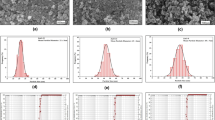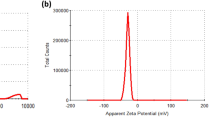Abstract
Purpose
Oxidative stress has been found to play a key role in several diseases, that range from cancer to neurodegenerative disorders. Besides traditional anti-oxidant agents, in recent years much attention has been focused on nanotechnological solutions, including cerium oxide nanoparticles (nanoceria).
Methods
Thanks to its extraordinary catalytic properties, nanoceria mimics the activity of superoxide dismutase and of catalase, therefore acting as a reactive oxygen species (ROS) scavenger in many biological contexts. In this paper, we report on nanoceria interactions with PC12 cell line, that represents a valuable model for many features of central dopaminergic neurons.
Results
Nanoceria confirmed a strong anti-ROS action but, most interestingly, also showed beneficial effects on both cell differentiation and dopamine production.
Conclusions
Even if deeper examinations will be necessary in order to better clarify the mechanisms at the base of the documented effects, nanoceria demonstrated a significant potential as pharmacological agent in the treatment of neurological disorders.






Similar content being viewed by others
Abbreviations
- EDS:
-
energy-dispersive X-ray spectroscopy
- ELISA:
-
enzyme-linked immunosorbent Assay
- NC:
-
nanoceria
- NGF:
-
nerve growth factor
- ROS:
-
reactive oxygen species
- XPS:
-
X-ray photoelectron spectroscopy
References
Asati A, Lehmkuhl D, Diaz D, Perez JM. Nanoceria facilitates the synthesis of poly(o-phenylenediamine) with pH-tunable morphology, conductivity, and photoluminescent properties. Langmuir. 2012;28:13066–71.
Esposito V, Traversa E. Design of electroceramics for solid oxide fuel cell applications: playing with ceria. J Am Ceram Soc. 2008;91:1037–51.
Pirmohamed T, Dowding JM, Singh S, Wasserman B, Heckert E, Karakoti AS, et al. Nanoceria exhibit redox state-dependent catalase mimetic activity. Chem Commun. 2010;46:2736–8.
Heckert EG, Karakoti AS, Seal S, Self WT. The role of cerium redox state in the SOD mimetic activity of nanoceria. Biomaterials. 2008;29:2705–9.
Celardo I, Traversa E, Ghibelli L. Cerium oxide nanoparticles: a promise for applications in therapy. J Exp Ther Oncol. 2011;9:47–51.
Niu J, Wang K, Kolattukudy P. Cerium oxide nanoparticles inhibits oxidative stress and nuclear factor-κb activation in H9c2 cardiomyocytes exposed to cigarette smoke extract. J Pharmacol Exp Ther. 2011;338:53–61.
Schubert D, Dargusch R, Raitano J, Chan SW. Cerium and yttrium oxide nanoparticles are neuroprotective. Biochem Biophys Res Commun. 2006;342:86–91.
Pagliari F, Mandoli C, Forte G, Magnani E, Pagliari S, Nardone G, et al. Cerium oxide nanoparticles protect cardiac progenitor cells from oxidative stress. ACS Nano. 2012;6:3767–75.
Hirst SM, Karakoti A, Singh S, Self W, Tyler R, Seal S, et al. Bio-distribution and in vivo antioxidant effects of cerium oxide nanoparticles in mice. Environ Toxicol. 2011. doi:10.1002/tox.20704.
Chen J, Patil S, Seal S, McGinnis JF. Rare earth nanoparticles prevent retinal degeneration induced by intracellular peroxides. Nat Nanotechnol. 2006;1:142–50.
Kong L, Cai X, Zhou X, Wong LL, Karakoti AS, Seal S, et al. Nanoceria extend photoreceptor cell lifespan in tubby mice by modulation of apoptosis/survival signaling pathways. Neurobiol Dis. 2011;42:514–23.
Zhou X, Wong LL, Karakoti AS, Seal S, McGinnis JF. Nanoceria inhibit the development and promote the regression of pathologic retinal neovascularization in the Vldlr knockout mouse. PLoS One. 2011;6:e16733.
Davan R, Prasad RGSV, Jakka VS, Aparna RSL, Phani AR, Jacob B, et al. Cerium oxide nanoparticles promotes wound healing activity in in-vivo animal model. J Bionanosci. 2012;6:78–83.
Celardo I, Pedersen JZ, Traversa E, Ghibelli L. Pharmacological potential of cerium oxide nanoparticles. Nanoscale. 2011;3:1411–20.
Reuter S, Gupta SC, Chaturvedi MM, Aggarwal BB. Oxidative stress, inflammation, and cancer: how are they linked? Free Radic Biol Med. 2010;49:1603–16.
Uttara B, Singh AV, Zamboni P, Mahajan RT. Oxidative stress and neurodegenerative diseases: a review of upstream and downstream antioxidant therapeutic options. Curr Neuropharmacol. 2009;7:65–74.
Bartsch H, Nair J. Chronic inflammation and oxidative stress in the genesis and perpetuation of cancer: role of lipid peroxidation, DNA damage, and repair. Langenbecks Arch Surg. 2006;391:499–510.
Kregel KC, Zhang HJ. An integrated view of oxidative stress in aging: basic mechanisms, functional effects, and pathological considerations. Am J Physiol Regul Integr Comp Physiol. 2007;292:18–36.
Janssen YM, Van Houten B, Borm PJ, Mossman BT. Cell and tissue responses to oxidative damage. Lab Invest. 1993;69:261–74.
Estevez AY, Erlichman JS. Cerium oxide nanoparticles for the treatment of neurological oxidative stress diseases. In: Oxidative stress: diagnostics, prevention, and therapy, ACS Symposium Series, 2011;1083:255–88.
Cimini A, D’Angelo B, Das S, Gentile R, Benedetti E, Singh V, et al. Antibody-conjugated PEGylated cerium oxide nanoparticles for specific targeting of Aβ aggregates modulate neuronal survival pathways. Acta Biomater. 2012;8:2056–67.
Estevez AY, Pritchard S, Harper K, Aston JW, Lynch A, Lucky JJ, et al. Neuroprotective mechanisms of cerium oxide nanoparticles in a mouse hippocampal brain slice model of ischemia. Free Radical Bio Med. 2011;51:1155–63.
Greene LA, Tischler AS. Establishment of a noradrenergic clonal line of rat adrenal pheochromocytoma cells which respond to nerve growth factor. Proc Natl Acad Sci USA. 1976;73:2424–8.
Le Bail A. Whole powder pattern decomposition methods and applications—A retrospection. Powder Diffr. 2005;20:316–26.
Romeo M, Bak K, El Fallah J, Lenormand F, Hilaire L. XPS study of the reduction of cerium dioxide. Surf Interface Anal. 1993;20:508–12.
Celardo I, De Nicola M, Mandoli C, Pedersen JZ, Traversa E, Ghibelli L. Ce3+ ions determine redox-dependent anti-apoptotic effect of cerium oxide nanoparticles. ACS Nano. 2011;5:4537–49.
Rzigalinski BA, Meehan K, Davis RM, Xu Y, Miles WC, Cohen CA. Radical nanomedicine. Nanomedicine UK. 2006;1:399–412.
Hussain S, Al-Nsour F, Rice AB, Marshburn J, Yingling B, Ji Z, et al. Cerium dioxide nanoparticles induce apoptosis and autophagy in human peripheral blood monocytes. ACS Nano. 2012;6:5820–9.
Tseng MT, Lu X, Duan X, Hardas SS, Sultana R, Wu P, et al. Alteration of hepatic structure and oxidative stress induced by intravenous nanoceria. Toxicol Appl Pharmacol. 2012;260:173–821.
Sohaebuddin SK, Thevenot PT, Baker D, Eaton JW, Tang L. Nanomaterial cytotoxicity is composition, size, and cell type dependent. Part Fibre Toxicol. 2010;7–22.
Asati A, Santra S, Kaittanis C, Perez JM. Surface-charge-dependent cell localization and cytotoxicity of cerium oxide nanoparticles. ACS Nano. 2010;4:5321–31.
Cooke MJ, Zahir T, Phillips SR, Shah DSH, Athey D, Lakey JH, et al. Neural differentiation regulated by biomimetic surfaces presenting motifs of extracellular matrix proteins. J Biomed Mater Res A. 2010;93:824–32.
Chien CL, Liu TC, Ho CL, Lu KS. Overexpression of neuronal intermediate filament protein α-internexin in PC12 cells. J Neurosci Res. 2005;80:693–706.
Wang J, Rahman MF, Duhart HM, Newport GD, Patterson TA, Murdock RC, et al. Expression changes of dopaminergic system-related genes in PC12 cells induced by manganese, silver, or copper nanoparticles. Neurotoxicology. 2009;30:926–33.
Patenaude A, Murthy MR, Mirault ME. Emerging roles of thioredoxin cycle enzymes in the central nervous system. Cell Mol Life Sci. 2005;62:1063–80.
Maher P. Redox control of neural function: background, mechanisms, and significance. Antioxid Redox Signal. 2006;8:1941–70.
Yoo MS, Chun HS, Son JJ, DeGiorgio LA, Kim DJ, Peng C, et al. Oxidative stress regulated genes in nigral dopaminergic neuronal cells: correlation with the known pathology in Parkinson’s disease. Brain Res Mol Brain Res. 2003;110:76–84.
Barbieri E, Sestili P. Reactive oxygen species in skeletal muscle signaling. J Signal Transduct. 2012;982794.
Fornai F, Lenzi P, Lazzeri G, Ferrucci M, Fulceri F, Giorgi FS, et al. Fine ultrastructure and biochemistry of PC12 cells: a comparative approach to understand neurotoxicity. Brain Res. 2007;1129:174–90.
Ulbrich K, Hekmatara T, Herbert E, Kreuter J. Transferrin- and transferrin-receptor-antibody-modified nanoparticles enable drug delivery across the blood–brain barrier (BBB). Eur J Pharm Biopharm. 2009;71:251–6.
Yoshida H, Date I, Shingo T, Fujiwara K, Kobayashi K, Miyoshi Y, et al. Stereotactic transplantation of a dopamine-producing capsule into the striatum for the treatment of Parkinson disease: a preclinical primate study. J Neurosurg. 2003;98:874–81.
Genchi GG, Ciofani G, Polini A, Liakos I, Iandolo D, Athanassiou A, et al. PC12 neuron-like cell response to electrospun poly(3-hydroxybutyrate) substrates. J Tissue Eng Regen M. 2012. doi:10.1002/term.1623.
Das S, Singh S, Dowding JM, Oommen S, Kumar A, Sayle TX, et al. The induction of angiogenesis by cerium oxide nanoparticles through the modulation of oxygen in intracellular environments. Biomaterials. 2012;33:7746–55.
Lord MS, Jung MS, Teoh WY, Gunawan C, Vassie JA, Amal R, et al. Cellular uptake and reactive oxygen species modulation of cerium oxide nanoparticles in human monocyte cell line U937. Biomaterials. 2012;33:7915–24.
Author information
Authors and Affiliations
Corresponding author
Rights and permissions
About this article
Cite this article
Ciofani, G., Genchi, G.G., Liakos, I. et al. Effects of Cerium Oxide Nanoparticles on PC12 Neuronal-Like Cells: Proliferation, Differentiation, and Dopamine Secretion. Pharm Res 30, 2133–2145 (2013). https://doi.org/10.1007/s11095-013-1071-y
Received:
Accepted:
Published:
Issue Date:
DOI: https://doi.org/10.1007/s11095-013-1071-y




